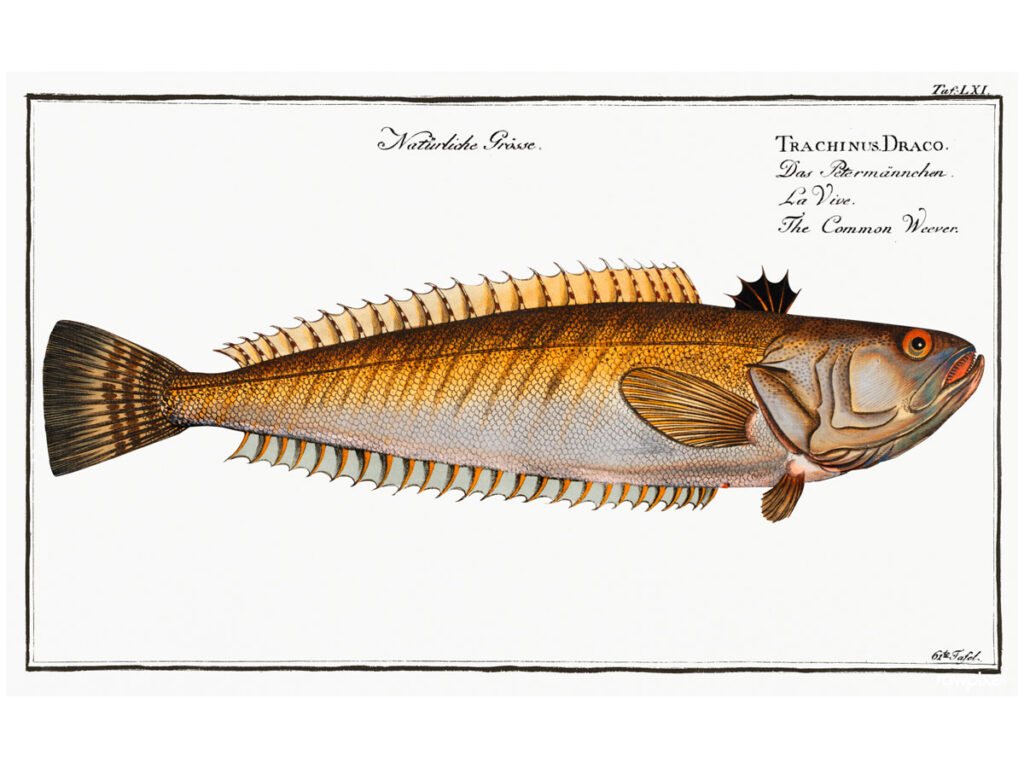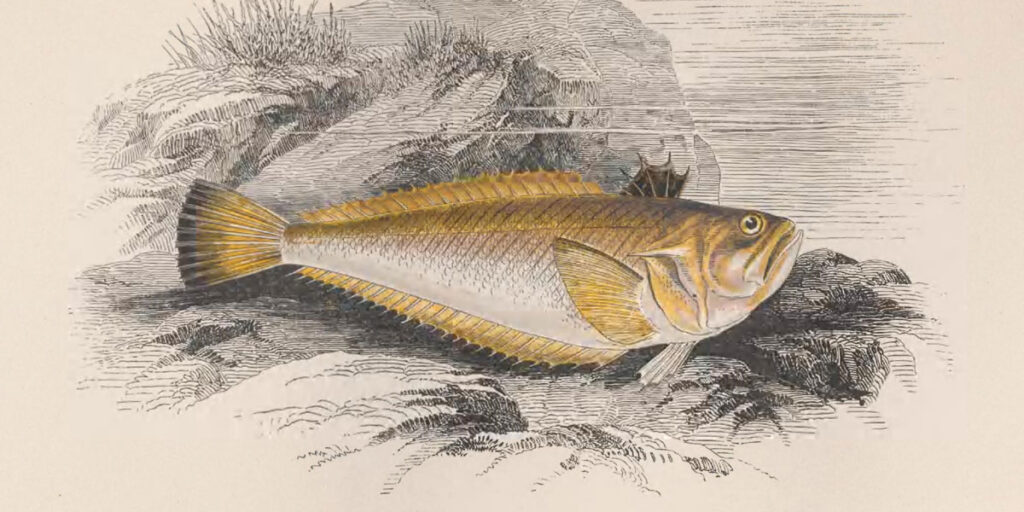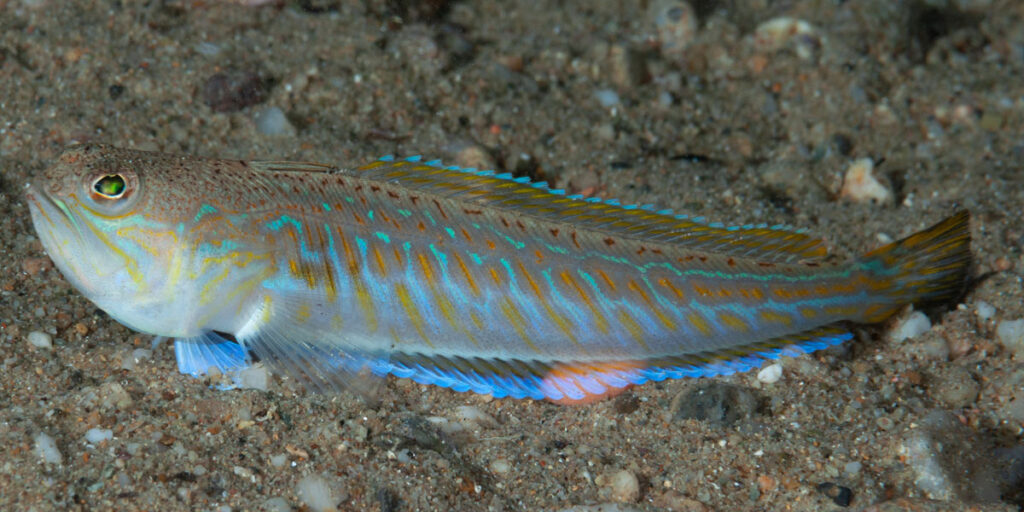
Last updated: 10 May, 2025 @ 12:11
From the middle of June until around the end of August it’s guaranteed that you’ll see alarming headlines warning of the seasonal appearance of the venomous weever fish.
This small, unpleasant looking fish, migrates to the shallows every summer, lying hidden, half-buried on the seabed waiting to bring misery to small crustaceans, fish – and paddling children.
Speaking from experience, the searing pain inflicted by the weever’s venomous dorsal fin is quite unlike any other.
The initial pin prick of discomfort quickly evolves, heating the foot from within to become a pressure cooker of unpleasantness (although those that say the pain is worse than childbirth are probably going a touch too far).
Once the foot is submerged in near-boiling water the pain quickly subsides, leaving only a dull, sore souvenir and the gift of being able to boast of having been stung by the favourite fish of factually incorrect headline writers everywhere (…tiny poisonous fish with agonising bite etc,.).
The inclusion of weever
However, this tale of weever woe doesn’t centre around a fiery foot, but rather a bland bouillabaisse.
The true origin of the bouillabaisse remains up for debate. This famous dish was undoubtedly born in the maddening city of Marseille, but by whose hand – fishermen at sea or the backstreet fishmongers, seeking a way to rid themselves of unsold fish.
Much like the dish’s roots, there seems to be no ‘true’ bouillabaisse recipe, but one thing does remain consistent – the necessary inclusion of weever in the dish.

Bouillabaisse abuse
In the now iconic book Floyd on France, Keith Floyd writes: ‘The French are passionate about fish stews, and don’t worry about the bones and bits. Of all kinds of fish stew, bouillabaisse is probably the best-known and most abused’.
By briefly searching a few online recipes for bouillabaisse it becomes immediate apparent what the late, great Keith Floyd means – with some warranting the inclusion of salmon and various unnamed ‘whitefish’.
Recipes do of course evolve, but it’s generally accepted that a good bouillabaisse must contain a rascasse (scorpion fish) or two, eel – either conger or moray, wrasse and our friend the weever.
Additional accepted ingredients can include John Dory, gurnard, dogfish and small crabs – along with a base of onion, leek, potatoes, garlic, tomatoes, thyme, fennel, orange peel, saffron, and of course, salt and pepper.
You’ll also need to muster up a rouille – which is a fiery paste of garlic, a walnut-sized piece of soaked bread and red chillies – and some beautiful aioli.
The weever: foot fetishist
Now, when it comes to the weever fish what few people tend to realise is that there are actually two species found in UK waters – the lesser, and the greater.
With its penchant for the human foot, it’s the infamous lesser weever which people tend to encounter the most.
Generally five to 10cm in length, the lesser weaver, aside from being a foot fetishist, favours shallower water – bringing it into contact with people.
Its slightly more handsome bigger brother, the greater weever, can grow up to around 40cm in length – its elongated body displaying golden-brown mottled markings – similar to an early 1980s fashion trend.
An offshore fish, the greater weever favours depths of around 30m to 100m, meaning very few people – excluding commercial fishermen – have encountered the species.
That includes some fishmongers, which presents a problem when looking to make a good bouillabaisse as it is the greater weever that’s integral to the dish.

Commands a reasonable price
Alan Davidson, in the must-have classic reference-come-cookbook, Mediterranean Seafood (read our review), notes that larger weever are also worth cooking in other ways.
He cites one Madame Audollent, who ‘performed the startling feat of providing 24 out of 48 prize-winning recipes at a congress held by the French Oceanographic Institute in 1926, and suggests grilling weever after marinating them in a mixture of olive oil, salt and pepper, chopped parsley and chopped shallots’ – the recipe was one of the winning 24.
Unfortunately, there isn’t a fishery for greater weever in the UK, with any fish caught being bycatch only.
This makes the greater weever a rare sight on the fishmonger’s slab – so rare in fact that one fishmonger told us: ‘I’ve never heard of it. What is it?’
That’s a shame, as an industry contact told Fish Face Seafood Blog that when the fish is occasionally landed in to UK ports, it usually commands a reasonable price – and goes to local buyers.
In contrast, on the French side of The Channel, greater weever is more commonly seen – its venomous dorsal fin removed, the fish ready to cook.
Sore point
So, the pain of my own weaver woe may be somewhat different to the one inflicted by the dorsal fin of this strange looking fish, but it remains a sore point – and my quest to find a greater weever and cook an ‘authentic’ bouillabaisse continues.
Further reading: Seafood Carbon Emissions Profiling Tool
If you’re a carbon-conscious consumer then you’ll love the new Seafood Carbon Emissions Profiling Tool released by Seafish.
Share this Fish Face Seafood Blog article.